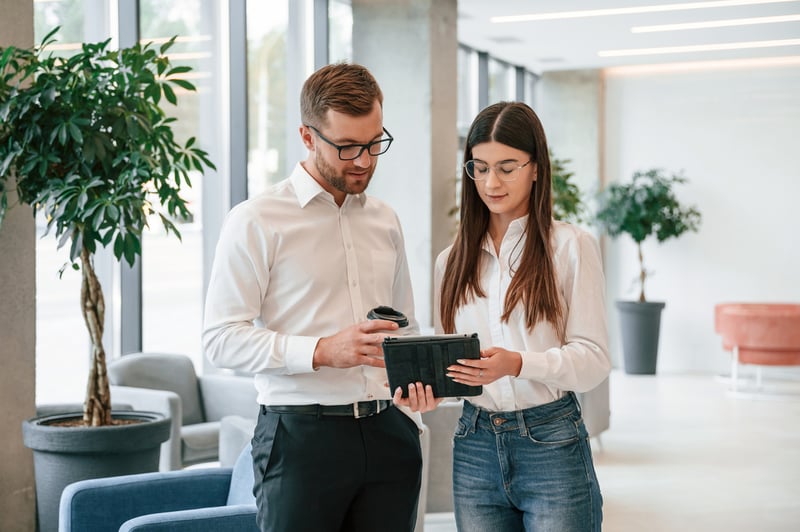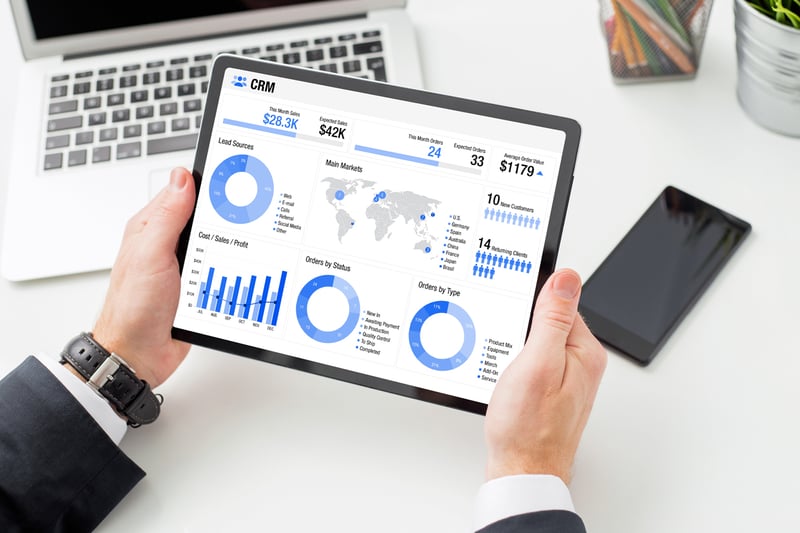Table of Contents
Upselling is like the extra slice of cheese on your burger or the whipped cream on your frappuccino. It's an additional, enticing offer that can elevate your experience to a whole new level. Mastering the art of upselling can make a difference in your revenue and customer satisfaction as a salesperson.
It's not just about pushing more products or services. It's about providing customers with valuable add-ons that enhance their overall experience.
This article will cover the top upselling examples that every salesperson needs to know. From suggesting complementary items to showcasing premium features, these techniques will help you increase your sales and make customers feel more satisfied with their purchases.
You can apply these strategies to various industries and products, whether you're selling in-person or online. So get ready to take your upselling game to the next level—let's dive in!
Why is Upselling Important?
Upselling is essential for businesses because it can increase revenue and profit margins. It's like adding a cherry to a sundae, except instead of a cherry, it's more money.
Here are some reasons why upselling is crucial:
- It encourages customers to buy more. When considering a purchase, suggesting related or complementary products can help your customers see the value in spending more money. For example, a fast-food chain might suggest adding fries and a drink to a burger order. This increases the customer's total spending and improves the overall customer experience.
- Upselling can improve customer satisfaction. When customers receive a customized upgrade offer, the business is genuinely interested in their needs and desires to provide an excellent experience. Content customers can bring substantial benefits; they are more likely to return for repeat purchases and recommend your company to others.
- It boosts profit margins. Upselling allows businesses to sell higher-priced products or services, which can increase their profit margins. For example, a car dealership might offer an upgraded trim level or add-on packages that significantly increase the vehicle's price.
- It's an effective sales strategy. Customers appreciate feeling valued and catered to, which makes upselling a natural part of the sales process. You can increase your revenue stream by offering premium or customized products that provide tangible benefits.
Upselling Strategy

Upselling strategies refer to techniques businesses use to encourage customers to purchase additional items or upgrades to their original purchase. You can achieve this through various methods, such as:
- Recommending complementary products,
- Discounting a higher-priced item, or
- Showcasing premium options.
Imagine ordering a burger with fries and a drink at a fast-food restaurant. The cashier asks, "Would you like to make that a large meal for just $0.50 more?" That's an example of an upselling strategy.
By throwing in that suggestion, the cashier has increased their chances of making a sale but, at the same time, has provided you with more value to think about.
Here are six upselling strategies with brief descriptions:
Bundling
Bundling is an upselling sales strategy that involves creating packages that combine your core product with complementary items.
For example, a camera store might bundle a new camera with a memory card, carrying case, and lens cleaning kit. By offering these items together at a discounted price, you incentivize the customer to spend more while providing them with a convenient solution.
Limited–Time Offer
Scarcity can be a powerful motivator. You can create a sense of urgency by offering upsells as limited-time promotions.
Here's a scenario: an electronics store might offer a free screen protector when purchasing a new phone, but only for the next three days. This strategy encourages customers to act quickly and take advantage of the additional value.
Premium Options
Upselling doesn't always have to be about price. You can also offer premium options that provide additional features or benefits.
For instance, a software company might offer a basic version of its product alongside a premium version with advanced features and priority customer support. This allows customers to choose the option that best suits their needs and budget.
Help Them Upsell Themselves
Sometimes, the best salespeople are the customers themselves. By asking insightful questions about their needs and goals, you can help them realize that a higher-tier product or service is a better fit.
For instance, a salesperson at a mattress store might ask about sleep habits and potential sleep disruptions, ultimately leading the customer to consider a mattress with added back support.
Master Upsell Timing
There's a sweet spot for upselling. If you approach a customer too early in the buying journey, they might feel pressured. However, waiting too long could mean they're already set on their initial purchase.
Look for natural pauses in the conversation, such as after they've expressed satisfaction with a product's features, to introduce upsell options.
Make it Easy to Say Yes
Don't make the upsell process cumbersome. Keep your upsell offers clear, concise, and highlight the added value the customer receives. Offer multiple payment options for bundled products or premium services and ensure the upsell process is smooth and frictionless.
Remember, upselling should always be done tactfully and in the customer's best interest. No one enjoys feeling coerced or manipulated into purchasing something they neither want nor need. By utilizing these strategies, you can discover creative solutions to provide customers value and ultimately improve your business's financial performance.
Benefits of Upselling

Upselling is a powerful sales tool that can help enterprises increase their revenue and satisfy customers with their purchases. As a result, some benefits of upselling include the following:
|
Benefits |
Description |
|
Boosts Revenue and Profit Margin |
Upselling encourages customers to spend more, leading to higher sales and profit margins. |
|
Enhances Customer Loyalty |
By providing additional value, upselling can increase customer satisfaction and loyalty. |
|
Simplifies Decision Making |
Bundled products or upsell options can simplify the buying process for customers who need multiple items. |
|
Increases Customer Lifetime Value |
Upselling can encourage customers to stay with your business for longer, increasing their lifetime value. |
|
Stand Out from Competitors |
Effective upselling strategies can differentiate your business from competitors by offering a more comprehensive and valuable customer experience. |
Boosts Revenue and Profit Margin
Upselling is a dependable way to maximize earnings and expand margins. Upselling appropriately allows customers to find more value than expected and can result in a 43% increase in your revenues and higher customer retention—extraordinary!
It all comes down to timing; offering your goods or services at the precise moment when customers are already interested can be incredibly successful.
Enhances Customer Loyalty
Businesses can foster customer loyalty by offering customers added value and more effective products through upselling. Suggesting relevant upgrades allows customers to feel appreciated and heard, thus making them more likely to return. Therefore, upselling is a unique way for companies to show their commitment to excellent service while building trust with clients.
A study by Retention Science found that increasing customer retention rates by just 5% can improve profits by 25% to 95%. For example, a hotel can upsell a room with a better view or additional amenities, creating a memorable experience for the guests and making them more likely to choose the same hotel.
Simplifies Decision Making
By upselling, customers will find it much simpler to decide as they are presented with the best options. This reduces the stress and confusion from too many available choices. Customer decision-making becomes easier and more efficient when you provide only the most ideal options.
An e-commerce clothing store, for instance, can suggest higher quality products designed to last longer and stand up to wear better. Using this approach, customers can make educated decisions with ease.
Increases Customer Lifetime Value
When you upsell strategically, you can increase the customer lifetime value of that customer. For instance, if a customer purchases a laptop from your store, you could offer them additional services such as extended warranties or technical support. This helps customers get more value for their money and builds loyalty in the long run.
According to research, repeat customers generate 41% of a company's revenue, despite only representing 8% of its customer base. For example, a car dealership can offer customers additional services like a maintenance plan, making the customer more likely to return for future car maintenance.
Customers will likely become more loyal and engaged with your brand by offering a more valuable item. Moreover, they will be more likely to recommend it to others. This increases the customer's lifetime value as they return for further purchases.
Stand Out from Competitors
Upselling can differentiate a business from its competitors by offering additional value and customized solutions. By providing a unique experience, customers will likely choose that business over others in the market. For example, a salon can enhance its customer experience by upselling a bespoke hair treatment tailored to the individual's hair type. This offers customers something unique and sets the salon apart from others nearby.
With the right approach and timing, businesses can leverage the power of upselling to create a win-win situation for themselves and their customers.
Upselling Examples

To fully grasp the concept of upselling, let's explore some real-world examples.
1. "Upgrade to a Bigger Size" - The Classic Upselling Technique
The most common upselling example is the "upgrade to a bigger size" technique. This method is popular in fast food restaurants, where the servers always ask if you want to make your meal larger for a few extra dollars.
A good example is when you order medium popcorn at a movie theater, the server may suggest upgrading to a large size for just a few extra dollars. This upsell increases the theater's revenue and makes customers feel they are getting a better deal.
2. "Complete the Look" - Upselling Accessories
Another popular upselling technique is to offer accessories that complement the original purchase. For example, when you buy a new dress, the sales associate may suggest adding a pair of shoes or a necklace to complete the look.
Retailers like Amazon and Sephora use this technique by suggesting additional products that complement the original purchase. Let's say you buy mascara from Sephora. Their website may suggest adding an eyeliner or eyeshadow palette to complete your makeup look.
As you can see, upselling can be highly beneficial for businesses. By offering relevant and complementary products, retailers can increase their average order value, resulting in more revenue per customer.
3. "Try Our Best-Selling Item" - Upselling Popular Products
Capitalize on the "try our best-selling item" technique to promote sales and get customers interested in trying new products. When people hear that a particular product is sought after or highly rated, they naturally become intrigued and more likely to purchase it. This approach not only boosts customer loyalty but also increases overall sales figures!
For instance, several restaurants use this upselling technique to their advantage by suggesting the most sought-after meal on their menu. Not only does it lead to higher sales for them, but it also grants customers a tangible assurance that they will love what is served!
4. "Upgrade Your Life" - Upselling Examples in Retail
Retail businesses have been using upselling techniques for years, and it's no wonder why - it works! Upselling in retail can take many forms, from suggesting a more expensive product to offering a complimentary item at the checkout.
For instance, a customer shopping for a new phone might be upsold to a more expensive model with more features. Or a shopper at a clothing store might be offered a discount on a second item when they purchase one at the full price. These tactics increase the store's revenue and make customers feel they're getting a great deal.
It is impressive that almost half of many consumers have purchased a product after being given a personalized recommendation despite not initially intending to do so. Therefore, upselling is a surefire way to increase sales and enhance customer relationships.
5. "Travel in Style" - Upselling Examples in the Airline Industry
Airlines have been luring customers with upgrades for years, from more spacious seating to onboard amenities. For instance, travelers can enjoy an exclusive first-class experience with superior comfort, unique culinary options, and personal service.
Research shows that most first-class passengers are willing to invest more in an improved seating experience. Hence, creating opportunities for seat upgrades is a successful way to enhance revenue and customer satisfaction simultaneously.
These upselling examples demonstrate that this marketing technique can benefit businesses and customers correctly. What's more, it allows companies to differentiate themselves from their competitors by providing the best possible experience for their customers!
6. "Use FOMO to Drive Upgrades" - Upselling Examples in SaaS
FOMO, or "fear of missing out," can be a powerful tool in SaaS upselling. Here's how to leverage it effectively:
- Limited-time access to new features: During the launch of a new, advanced feature within your SaaS product, offer a free trial period exclusive to existing customers on higher-tier plans. This creates a sense of urgency for customers on basic plans to upgrade and access the new functionality before the trial ends.
- Highlight case studies of successful upgrades: Showcase success stories of customers who upgraded to a higher plan and achieved significant results. This demonstrates the tangible benefits of upgrading and taps into the fear of missing out on similar growth or efficiency gains.
- Exclusive access to premium content or resources: Offer valuable resources, such as white papers, webinars, or online courses, exclusively to customers on premium plans. This incentivizes lower-tier subscribers to upgrade to gain access to these exclusive insights.
7. "Highlight Benefits that Relate to Your Customer" - Upselling Examples in Insurance
In the insurance industry, upselling is about ensuring customers have the right coverage for their evolving needs. Here's how to personalize upsells based on customer profiles:
- Young professionals: For young professionals with growing assets, you could upsell a renters insurance policy with increased personal property coverage or offer an add-on for valuable electronics.
- New homeowners: For new homeowners, you could upsell from a basic homeowners insurance policy to one that includes replacement cost coverage or additional protection against natural disasters common in their area.
- Families: Here, you could upsell life insurance policies to ensure financial security for loved ones or offer riders on existing policies to cover children's education.
Upselling Techniques

Upselling without a strategy can be tricky, so having some techniques in place is essential. Here are a few upselling tactics that you can use:
1. Focus on Your Customer's Needs
This might sound obvious, but it's crucial to ensure that your upselling efforts are always in line with the customer's needs. When you focus on your customer's needs, you're not just upselling them—you're delivering a solution that meets their needs.
2. Create Packages and Bundles
Another great tactic is to create packages or bundles of products at discounted prices. This allows customers to purchase multiple items for a lower price, encouraging them to spend more money with your business.
In this scenario, a restaurant could offer a set menu with an appetizer, main course, and dessert at a discounted price. This way, customers are more likely to order multiple items instead of just one.
3. Use Comparisons and Reviews
The power of word-of-mouth marketing or reviews is hard to deny, so using comparisons and reviews to upsell is an effective tactic. If a customer has their eyes on a product but is unsure if it's worth the price tag, comparing charts or reviews from past customers can help them decide.
Doing this gives the customer more information and adds more credibility to their decision-making process.
4. Customize Your Customers' Experiences
Now, more than ever, customers are looking for experiences tailored to their needs. Personalizing upselling efforts is a great way to show that you value your customers and are willing to go the extra mile for them.
For instance, instead of automatically suggesting a higher-priced product, you can ask the customer what they're looking for and recommend something that best meets their needs. This can be especially effective in industries such as fashion, where customers are looking for something special and unique.
When you personalize your upselling strategies, you're more likely to create connections with your customers and encourage them to continue doing business with you.
5. Offer Promotions and Discounts
Promotions and discounts are effective upselling techniques, as they help to reduce the cost of a product or service for customers. This can be attractive enough to entice them into buying more than initially planned.
For instance, offering 10% off when someone purchases two items instead of one can encourage them to add that second item. A practical method of increasing your company's profit margins is to add shipping fees to the prices you set for products— research has found this can boost profits by up to 26%!
You can list that product with a free shipping tag as an upselling technique, making customers more likely to buy the item.
6. Use Incentives
Incentives are another great way to get customers to purchase more products or services. Providing rewards such as coupons, store credits, loyalty points, or discounts on future purchases can effectively drive sales. In addition, providing special offers on select products or services can also help increase the number of orders placed by customers.
7. Follow-Up
Following up with potential customers is essential when it comes to upselling techniques, as it allows you to stay in touch with them and remind them of your product or service offerings. Having a system that reaches out regularly can help keep your brand top-of-mind and ensure your offerings don't slip through the cracks.
By sending personalized drip email campaigns based on customer data and past purchases, businesses can see an increase in revenue. When creating these follow-up campaigns, it's essential to use language encouraging customers to act. Providing incentives such as discounts or special offers can help make the message more compelling.
These are just a few upselling techniques businesses can use to encourage customers to buy more from them. Using the right tactics, companies can increase their profits while providing customers with an enjoyable shopping experience.
Common Upselling Phrases

Upselling is often done through verbal communication, so it's vital to use upselling phrases to convince customers to purchase the upgraded product. However, you can also use these phrases in emails, SMS messages, and other written materials. Here are 15 examples of upselling phrases you can use to encourage customers to take advantage of the offer:
- "Would you like to upgrade to our premium package for just a few dollars more?"
- "You're getting a great deal with this product, but have you considered adding on this newer version for even more value?"
- "For a limited time, you can upgrade to our deluxe version for a small extra cost."
- "Have you seen our bundle deal? You'll save even more money by adding on this complementary item."
- "I noticed you're interested in [product]. Have you considered [related product] as well? It's the perfect complement."
- "If you sign up for our loyalty program, you'll get exclusive discounts and offers."
- "For just a little extra, you can upgrade to the next level and enjoy additional benefits."
- "Did you know that adding [product] will save money in the long run?"
- "We have a special promotion right now where you can save even more by adding [related product] to your purchase."
- "Our most satisfied customers often choose to add [related product] to their purchase. Would you like to learn more?"
- "If you add [related product], you'll be able to take advantage of all the features and benefits of this product."
- "Our top customers often choose to upgrade to our premium version. Would you like to learn more about the benefits?"
- "Adding [product] will enhance your experience and make your purchase even more enjoyable."
- "By adding [related product], you'll be able to achieve your desired results even faster and more effectively."
- "If you buy two, we can offer you a 10% discount on your total purchase."
With the right strategy, upselling can effectively boost profits and keep customers returning for more.
How to Improve Upselling

As you already understand, upselling can be a powerful tool for increasing revenue and boosting customer satisfaction. So, here are some tips on how to do it effectively:
1. Know Your Target Audience
To upsell effectively, you need to know your target audience well. Understanding their needs and preferences will help you offer products or services that will benefit them. You can segment your customers based on their past purchase history or demographic information and tailor your upselling strategy to each segment.
For example, a fitness equipment store might classify its customers into two groups: gym regulars and home exercise devotees. The gym-goers might be more interested in high-end, professional-grade equipment, while the home workout enthusiasts may prefer more affordable, space-saving options.
2. Use a CRM
A customer relationship management system can help you track and manage your interactions with customers, including their purchase history, preferences, and behavior. This data can then be used to personalize your upselling strategy and make it more effective.
Here are some CRM features that can aid in upselling:
|
Features |
Description |
|
Group customers based on specific criteria, such as purchase history or demographics. |
|
|
Sales pipeline management |
Track where each customer is in the sales process, from lead to close. |
|
Personalization |
Use customer data to personalize your upselling approach, such as addressing them by name or offering products that align with their past purchases. |
|
Use historical data to predict future sales trends and adjust your upselling strategy accordingly. |
3. Compare Products
When upselling, it's essential to highlight the differences between the product the customer intends to purchase and the higher-priced or upgraded version you're offering. By emphasizing the added value of the more expensive product, you can make the customer feel like they're getting a better deal.
For example, a customer may have their sights set on buying a basic smartphone model. But, with the right sales pitch, they could be convinced to upgrade to one that's decked out with better camera quality, longer battery life, and increased storage capacity.
4. Don't Be Pushy
No one likes a pushy salesperson, which is why it's essential to remain respectful and polite when upselling. Customers are more likely to purchase if they feel like you're making sincere recommendations instead of just trying to get them to buy something unnecessary.
Try phrases such as "I think this would work best for you" or "You might find this more beneficial in the long run" to give them an idea of what the product can do. Customers appreciate being given helpful advice, so don't forget to be courteous and considerate during your upselling attempts.
5. Focus on Trading Value for Value
The best way to upsell is by offering a higher-priced product that provides more value for the customer. Instead of just increasing the price, ensure you're increasing the level of value as well.
Let's assume you're selling a laptop. It would be wise to upsell customers on one with an extended warranty or additional features such as higher RAM or a faster processor. That way, customers can better appreciate what they're getting in return for their extra money.
Conclusion
Upselling is an effective way to increase sales and provide customers with additional value. By leveraging customer segmentation, personalized upsells, and sales forecasting, you can create a successful upselling strategy that drives more revenue for your business. It's important to remember the fundamental principles of upselling, such as trading value for value and timing it correctly to maximize success.
If you need help implementing these strategies or want guidance on using CRM features that Ringy offers, reach out today! Our team of experts is here and ready to get started helping you drive more sales through strategic upselling tactics.
